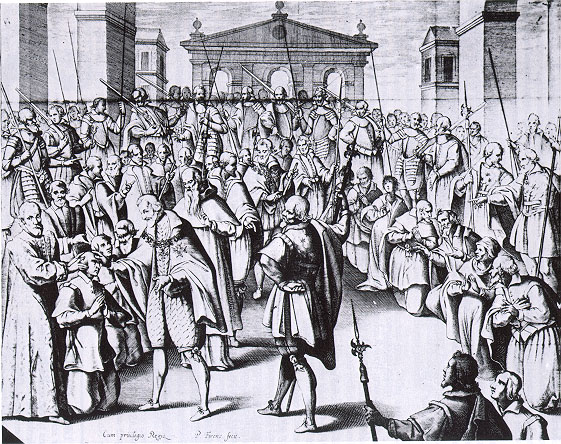- Scrofula
Infobox_Disease
Name = PAGENAME

Caption = King Henry IV of France touching a number of sufferers of scrofula who are gathered about him in a circle. André de Laurens, 1609
DiseasesDB = 31259
ICD10 = ICD10|A|18|4|a|15
ICD9 = ICD9|017.2
ICDO =
OMIM =
MedlinePlus =
eMedicineSubj = ent
eMedicineTopic = 524
MeshID = D014388Scrofula (scrophula or struma) is any of a variety of
skin disease s; in particular, a form oftuberculosis , affecting thelymph node s of the neck. In adults it is caused by "Mycobacterium tuberculosis " and in children bynontuberculous mycobacteria . The word comes from theLatin "scrofula", meaning "broodsow ".History
In the
Middle Age s it was believed that "royal touch", the touch of thesovereign ofEngland orFrance , could cure the disease. Scrofula was therefore also known as the King's Evil. The kings were thought to have received this power due to their descent fromEdward the Confessor , who, according to some legends, received it fromSaint Remigius . From 1633, theBook of Common Prayer of theAnglican Church contained a ceremony for this, and it was traditional for themonarch (king or queen) to present to the touched person acoin — usually an Angel, agold coin the value of which varied from about 6shillings to about 10 shillings. KingHenry IV of France is reported as often touching and healing as many as 1,500 individuals at a time.Queen Anne touched the infant (later Doctor)
Samuel Johnson in 1712 [Henry Hitchings “Dr Johnson's Dictionary:The extraordinary story of the book that defined the World” Pub. John Murray 2005 P.11] , but King George I put an end to the practice as being "tooCatholic ." The kings of France continued the custom untilLouis XV stopped it in the 1700s, though it was briefly revived to universal derision in 1825.In 1768 the Englishman
John Morley produced a handbook "Essay on the nature and cure of scrophulous disorders, commonly called the King's Evil". The book starts by listing the typical symptoms and indications of how far the disease had progressed. It then goes into detail with a number of case studies, describing the specific case of the patient, the various treatments used and their effectiveness. The forty-second edition was printed in 1824.In 1924, French historian
Marc Bloch wrote a book on the history of the royal touch: "The royal touch: sacred monarchy and scrofula in England and France" (original in French).The disease
Scrofula is the term used for tuberculosis of the neck, or, more precisely, a "cervical tuberculous lymphadenopathy". Scrofula is usually a result of an infection in the
lymph nodes , known aslymphadenitis and is most often observed inimmunocompromised patients (about 50% of cervical tuberculous lymphadenopathy). About 95% of the scrofula cases in adults are caused by "Mycobacterium tuberculosis", but only 8% of cases in children. The rest are caused by atypical mycobacterium ("Mycobacterium scrofulaceum)" or nontuberculous mycobacterium (NTM). With the stark decrease of tuberculosis in the second half of the20th century , scrofula became a very rare disease. With the appearance ofAIDS , however, it has shown a resurgence, and presently affects about 5% of severely immunocompromised patients.Fact|date=March 2007igns and symptoms
The most usual signs and
symptom s are the appearance of a chronic, painless mass in theneck , which is persistent and usually grows with time. The mass is referred to as a "cold abscess", because there is no accompanying local color or warmth and the overlying skin acquires a violaceous (bluish-purple) color. NTM infections do not show other notable constitutional symptoms, but scrofula caused by tuberculosis is usually accompanied by other symptoms of the disease, such asfever ,chill s,malaise andweight loss in about 43% of the patients. As the lesion progresses, skin becomes adhered to the mass and may rupture, forming asinus and an openwound .Diagnosis
Diagnosis is usually performed byneedle aspiration biopsy or excisionalbiopsy of the mass and the histological demonstration of stainableacid-fast bacteria in the case of infection by "M. tuberculosis" (Ziehl-Neelsen stain ), or the culture of NTM using specific growth and staining techniques.Therapy
Treatment approaches are highly dependent on the kind of infection. Surgical excision of the scrofula does not work well for "M. tuberculosis" infections, and has a high rate of
recurrence and formation offistula e. Furthermore, surgery may spread the disease to other organs. The best approach then is to use conventional treatment of tuberculosis withantibiotics . Scrofula caused by NTM, on the other hand, responds well tosurgery , but is usually resistant to antibiotics. The affected nodes can be removed either by repeated aspiration,curettage or total excision (with the risk in the latter procedure, however, of causing cosmetically negative effects or damage to thefacial nerve , or both).Prognosis
With adequate treatment, clinical remission is practically 100%. In NTM infections, with adequate surgical treatment, clinical remission is greater than 95%. It is recommended that persons in close contact with the diseased person, such as family members, should undergo testing for tuberculosis.
ee also
*
Tuberculosis diagnosis
*Tuberculosis treatment
*Touch Pieces Notes
References
* Badger, J., "A Collection of Remarkable Cures of the King's Evil, Perfected by the Royal Touch, by John Badger, Apothecary", M. Cooper, (London), 1748.
* Bloch, M. (Anderson, J. E., trans), "The Royal Touch: Sacred Monarchy and Scrofula in England and France (Les Rois Thaumaturges)", Routledge & Kegan Paul, (London), 1973.
* Collet, S. [pseud. of Percy, R.] , "Touching for the King’s Evil", pp.356-359 in Collet, S., "Relics of Literature by Stephen Collet, A.M.", Thomas Boys, (London), 1823.
* Crawfurd, R.H.P., "The King's Evil", Oxford University Press, (Oxford), 1911.External links
* [http://www.emedicine.com/ent/topic524.htm Scrofula] from eMedicine medical article
* [http://http://rad.usuhs.edu/medpix/medpix_image.html?mode=quiz&quiz=no&pt_id=12154&imid=44129&comebackto=mode=pt_finder#top Scrofula] MedPix(r) Images
Wikimedia Foundation. 2010.
